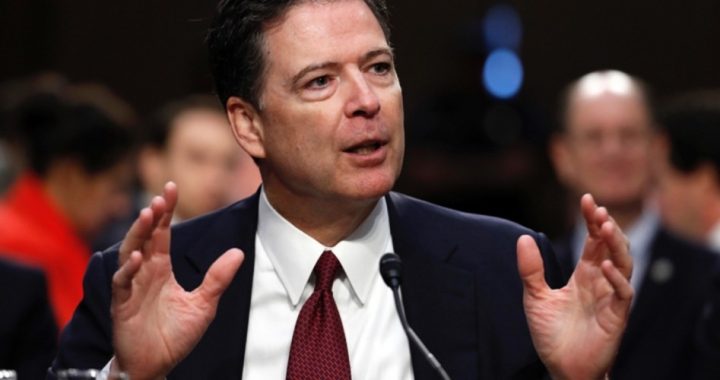
As former FBI Director James Comey (shown) prepared to testify before the Senate Intelligence Committee on Thursday, he prepared a statement that he provided to the Committee and released to the press Wednesday. That statement — which he did not read during his testimony, but is still considered part of his testimony — detailed his written record of his private conversations with Donald Trump, both as president-elect and president.
After being sworn in, Comey told the committee, “I’ve submitted my statement for the record and I’m not going to repeat it here this morning.” He then proceeded to confirm, in his oral testimony, the points he had covered in that prepared statement.
In all, according to Comey’s written statement, he had five private encounters with Trump. Those were the January 6 briefing by the heads of the intelligence agencies in a conference room at Trump Tower, a private dinner in the green room at the White House on January 27, a February 14 Oval Office meeting, a March 30 phone call, and another phone call on April 11.
In his prepared testimony, Comey admitted what he had previously refused to admit publicly: President Trump was telling the truth when he said that Comey had told him on three separate occasions that the president was not under investigation.
The first time Comey told Trump he was not the subject of an investigation was after the January 6 briefing of the president-elect by the heads of intelligence. Comey wrote that he had been chosen by the director of national intelligence to make Trump aware of the “salacious and unverified” dossier purported to be the product of a former British intelligence agent. Comey wrote, “Although we agreed it made sense for me to do the briefing, the FBI’s leadership and I were concerned that the briefing might create a situation where a new President came into office uncertain about whether the FBI was conducting a counter-intelligence investigation of his personal conduct.”
“At the conclusion of that briefing,” Comey “remained alone with the President Elect to brief him” on the dossier that had been circulating for months among media and was being prepared for publication. Comey wrote that he had previously “discussed with the FBI’s leadership team whether I should be prepared to assure President-Elect Trump that we were not investigating him personally,” adding, “That was true; we did not have an open counter-intelligence case on him.” He also wrote, “We agreed I should do so if circumstances warranted.”
Comey’s written testimony went on to say, “During our one-on-one meeting at Trump Tower, based on President Elect Trump’s reaction to the briefing and without him directly asking the question, I offered that assurance.”
The second time Comey told Trump there was no investigation of him was during the private dinner at the White House on January 27. Comey wrote:
During the dinner, the President returned to the salacious material I had briefed him about on January 6, and, as he had done previously, expressed his disgust for the allegations and strongly denied them. He said he was considering ordering me to investigate the alleged incident to prove it didn’t happen. I replied that he should give that careful thought because it might create a narrative that we were investigating him personally, which we weren’t, and because it was very difficult to prove a negative. He said he would think about it and asked me to think about it.
The third and final time Comey told Trump that he was not the subject of an investigation was during a phone conversation between the two on March 30. Comey wrote that the president called him that morning “at the FBI” and “described the Russia investigation as ‘a cloud’ that was impairing his ability to act on behalf of the country.” During that call, President Trump asked Comey about “what we could do to ‘lift the cloud’” and about “why there had been a congressional hearing about Russia the previous week.” Comey wrote:
I explained the demands from the leadership of both parties in Congress for more information, and that Senator Grassley had even held up the confirmation of the Deputy Attorney General until we briefed him in detail on the investigation. I explained that we had briefed the leadership of Congress on exactly which individuals we were investigating and that we had told those Congressional leaders that we were not personally investigating President Trump. I reminded him I had previously told him that. He repeatedly told me, “We need to get that fact out.”
In the last conversation before Trump fired Comey — a phone call on April 11 — Trump again brought the matter up, but Comey did not specifically address it.
So, Trump’s claims — that Comey had told him on three separate occasions that he was not under investigation, that both houses of congress were aware that he was not under investigation, and that he had expressed frustration about the “cloud” that was created by Comey’s unwillingness to say so publicly — were all true. Conversely, reports by the liberal mainstream media that Trump was lying about it are now — by Comey’s own testimony — shown to be “fake news.”
Photo: AP Images




